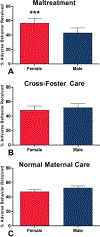Female pups receive more maltreatment from stressed dams
- PMID: 30810229
- PMCID: PMC6711830
- DOI: 10.1002/dev.21834
Female pups receive more maltreatment from stressed dams
Abstract
The effects of exposure to developmental stress often diverge for males and females. Using the scarcity-adversity model of low nesting resources outside the home cage, our lab has discovered sex differences in both behavioral and epigenetic consequences of repeated exposure to caregiver maltreatment. For the measures we have performed to date, we have found more consequences for females. The reasons underlying this sex disparity are unknown. In the current experiment, we aimed to discern the quality of maternal care received by male and female pups in our model. As we have previously found more behavioral and epigenetic consequences in females, we hypothesized that females receive more adverse care compared to their male littermates. Our hypothesis was supported; in our maltreatment condition, we found that female pups received more adverse care than males. This sex difference in adverse care was not present in our two control conditions (cross-foster and normal maternal care). These data lend support to the notion that one reason females in our model incur more behavioral and epigenetic consequences is a result of greater mistreatment by the dam.
Keywords: early-life stress; maltreatment; maternal care; sex differences.
© 2019 Wiley Periodicals, Inc.
Figures



Similar articles
-
Phenotypic outcomes in adolescence and adulthood in the scarcity-adversity model of low nesting resources outside the home cage.Dev Psychobiol. 2017 Sep;59(6):703-714. doi: 10.1002/dev.21547. Epub 2017 Aug 2. Dev Psychobiol. 2017. PMID: 28767135 Free PMC article.
-
Differential methylation of genes in the medial prefrontal cortex of developing and adult rats following exposure to maltreatment or nurturing care during infancy.Dev Neurosci. 2013;35(4):306-16. doi: 10.1159/000350716. Epub 2013 Jun 8. Dev Neurosci. 2013. PMID: 23751776 Free PMC article.
-
Pharmacological manipulation of DNA methylation normalizes maternal behavior, DNA methylation, and gene expression in dams with a history of maltreatment.Sci Rep. 2019 Jul 16;9(1):10253. doi: 10.1038/s41598-019-46539-4. Sci Rep. 2019. PMID: 31311968 Free PMC article.
-
Are age and sex differences in brain oxytocin receptors related to maternal and infanticidal behavior in naïve mice?Horm Behav. 2016 Jan;77:132-40. doi: 10.1016/j.yhbeh.2015.04.006. Epub 2015 Apr 22. Horm Behav. 2016. PMID: 25910577 Review.
-
Parental potentiation of vocalization as a marker for filial bonds in infant animals.Dev Psychobiol. 2014 Dec;56(8):1689-97. doi: 10.1002/dev.21222. Epub 2014 Jun 10. Dev Psychobiol. 2014. PMID: 24915803 Review.
Cited by
-
Becoming Stressed: Does the Age Matter? Reviewing the Neurobiological and Socio-Affective Effects of Stress throughout the Lifespan.Int J Mol Sci. 2020 Aug 13;21(16):5819. doi: 10.3390/ijms21165819. Int J Mol Sci. 2020. PMID: 32823723 Free PMC article. Review.
-
Infant ultrasonic vocalizations predict adolescent social behavior in rats: Effects of early life adversity.Dev Psychobiol. 2022 Mar;64(3):e22260. doi: 10.1002/dev.22260. Dev Psychobiol. 2022. PMID: 35312059 Free PMC article.
-
Understanding the association between adverse childhood experiences and subsequent attention deficit hyperactivity disorder: A systematic review and meta-analysis of observational studies.Brain Behav. 2022 Oct;12(10):e32748. doi: 10.1002/brb3.2748. Epub 2022 Sep 6. Brain Behav. 2022. PMID: 36068993 Free PMC article.
-
Postpartum scarcity-adversity disrupts maternal behavior and induces a hypodopaminergic state in the rat dam and adult female offspring.Neuropsychopharmacology. 2022 Jan;47(2):488-496. doi: 10.1038/s41386-021-01210-3. Epub 2021 Oct 26. Neuropsychopharmacology. 2022. PMID: 34703012 Free PMC article.
-
Synthesizing Views to Understand Sex Differences in Response to Early Life Adversity.Trends Neurosci. 2020 May;43(5):300-310. doi: 10.1016/j.tins.2020.02.004. Epub 2020 Mar 16. Trends Neurosci. 2020. PMID: 32353334 Free PMC article. Review.
References
-
- Alessandri SM, & Lewis M (1996). Differences in pride and shame in maltreated and nonmaltreated preschoolers. Child Development, 67(4), 1857–1869. - PubMed
-
- Alleva E, Caprioli A, & Laviola G (1989). Litter gender composition affects maternal behavior of the primiparous mouse dam (Mus musculus). Journal of Comparative Psychology, 103(1), 83–87. - PubMed
-
- Aznar A, & Tenenbaum HR (2015). Gender and age differences in parent–child emotion talk. British Journal of Developmental Psychology, 33(1), 148–155. - PubMed
-
- Banyard VL (1997). The impact of childhood sexual abuse and family functioning on four dimensions of women’s later parenting. Child Abuse & Neglect, 21(11), 1095–1107. - PubMed
Publication types
MeSH terms
Grants and funding
LinkOut - more resources
Full Text Sources
Medical
Research Materials

